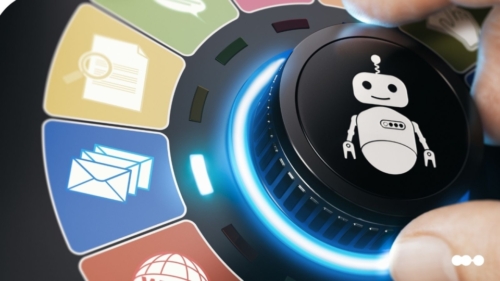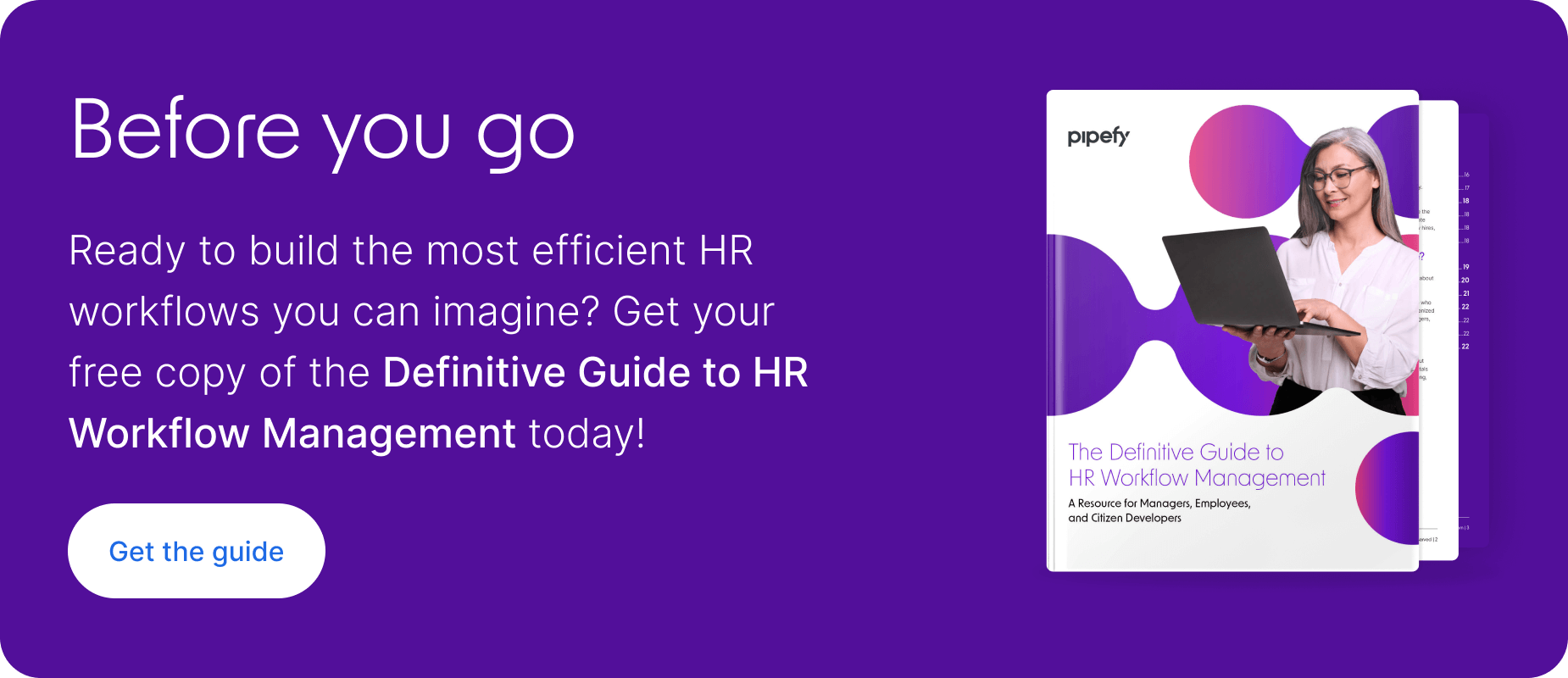
What is an HR ticketing system?
An HR ticketing system automates employee requests so they can be captured, organized, and resolved with speed and consistency. With an HR ticketing system, an employee can submit a ticket for questions about pay, benefits, timekeeping, or other HR-related issues. The ticket is then assigned to the department or team who can resolve it. While the ticket is active, the requestor can monitor its progress. Once the ticket is resolved, the employee will receive a response.
Metrics are also tracked with an HR ticketing system, making it easy to see what kind of issues arise most often, where breaks exist within payroll or timekeeping, and how efficient your HR specialists are in resolving employee requests.
Definitive Guide to HR Workflow ManagementDownload now
Why an HR helpdesk ticketing system is a must-have
HR requests are some of the most common — and complex — in any organization. Depending on the request type, employee requests may require input or action from team members in other departments.
For example, if the ticket is for new equipment, the request will likely need to be reviewed by a manager, the IT team, and the purchasing or procurement team. Other types of requests may require assistance from finance, payroll, benefits, or operations teams.
Once you’ve worked with the support of an HR helpdesk system, it’s difficult to imagine an efficient workflow that doesn’t include this helpful tool. HR ticketing systems offer a myriad of benefits for HR departments, employees, managers, and organizations. Here’s how.
Better communication
Without a ticketing system, employees catch HR reps wherever and whenever they find them. As a result, requests are often forgotten, missing information, or never resolved at all. And even if the request is remembered and somebody is working on it, there’s no visibility for the employee. This creates a situation where they may believe their ticket hasn’t been received or isn’t being prioritized.
An HR automation ticketing system gives the employee insight into ticket progress and real-time updates. By adding in a layer of process automation, this is also a great solution for resolving delays and improving asynchronous collaboration.
More productivity
Ticketing systems allow employees to submit and HR teams to manage and resolve tickets quickly and easily. Because employees have visibility into the progress of their request, HR teams spend less time following up with employees and tracking down progress reports.
Ticketing systems also give HR team members quick access to intuitive to-do lists ordered by priority. This helps them put out work fires in a timely manner, prevent future fires from starting, easily prioritize their work, and meet employee and team expectations.
Reduced SLA
Ticketing systems help ensure employee requests are resolved faster. With clear visibility into the requests that are awaiting resolution, the number of days they’re open, and the level of risk involved with each request, HR team members can work on cases with the highest impact and shortest SLAs first.
Look for a system that allows you to set a standard deadline or timeline for when to complete a request by, and alerts you if requests have been active for longer than the defined SLA.
Improved employee satisfaction
By giving employees a convenient way to submit tickets, communicate throughout the process, and refer to an easily-accessible request record, an HR ticketing system improves the overall employee experience which leads to higher employee satisfaction.
What are the essential features of an HR ticketing system?
When comparing HR ticketing systems, be sure to evaluate them against these essential functions and features.
Ready-to-use templates
The ideal system offers ready-to-use templates for common ticket types that are customizable for your organization. For example, you can choose to use the ready-to-use template for payroll questions, benefits questions, or access questions and then customize to meet your needs. If your organization needs fewer or additional data points, a system with customizable, ready-to-use templates will support that.
Forms
Ideally, your ticketing system will offer customizable forms, so you can move away from paper-based processes. Electronic forms allow for digital document creation, electronic signatures, and electronic filing, so audit trails are easily accessible and nothing gets lost in the shuffle.
Forms that use rules and conditionals can prevent missing or incomplete information, which eliminates the need for unnecessary follow up. Some systems also offer reminder emails or notifications when a form has been awaiting signature for a specified period of time, improving compliance with established workflows.
Shared inbox
A shared inbox is beneficial for both employees and HR teams. In addition to centralizing requests or follow-ups, a shared inbox also:
- Streamlines communication. Employees only refer to a single email address to ask HR questions.
- Centralizes requests. The email address doesn’t change when HR team members leave or join the team.
- Ensures no message is left unanswered. The email is still received by somebody who is in office when their primary point of contact is on leave or out of the office
- Help HR teams delegate high volumes of work. Work is naturally divided between team members, avoiding overload of one rep and underutilization of another.
Automation
Automation takes the manual work out of repetitive, clerical tasks. Any HR system that meets the needs of your organization will automate repetitive tasks for employees, HRBPs, and managers.
For example, your HR team members should be able to resolve a ticket in the HR ticketing system, and the employee should automatically receive an email letting them know how their case was resolved and that their ticket has been closed. There is no need to draft an additional email after resolving the issue and adding notes in the system.
Dashboards and analytics
Dashboards and analytics offer transparency around ticket themes and volumes, workload breakdown among HR specialists, and more. This allows managers to identify and solve the root cause of common employee problems and staff your HR department according to volume and complexity of cases.
The best HR ticketing systems will allow customization of dashboards and reports so you can see the data that’s most meaningful for your company and that can be used to optimize existing business or HR processes.
Tips to improve your HR support
Use the right software
The single most impactful change you can make is to implement HR ticketing software to automate the ticketing process, improving communication and timelines for employees.
Look for an automation software that:
- Prevents requests from falling through the cracks.
- Ensures timely responses and resolutions.
- Provides visibility into the work toward resolution while a ticket is in progress.
- Improves satisfaction for both HR team members and employees.
Build an internal self-help portal
An internal knowledge base or portal is a repository of policies, procedures, and helpful documents like tip sheets, instructions, and communications.
By building an internal knowledge base, searchable through your ticketing software, you give employees the power to find the answers to their own questions in real time. As a result, employees get what they need quicker and the number of tickets submitted is naturally reduced.
Collect feedback
Provide employees with an opportunity to share feedback after each case is closed so you can identify areas of opportunity and focus on making continuous improvements.
An HR ticketing system can automate the process of collecting information and the process of tallying results into meaningful metrics for you. HR teams can also create an automation that shares a feedback request form or survey with employees once their ticket has been resolved.
Common questions to ask include:
- Was the response you received to your ticket helpful?
- Were the knowledge base articles you found or received beneficial in providing information?
- Was the representative who resolved your ticket professional and courteous?
- Would you use the ticketing system to submit a request in the future?
Create a human-centered HR helpdesk with Pipefy
Easily organize and track all HR requests with Pipefy’s business process automation software. With its visual user interface and automated notification features, HR teams can quickly and accurately respond to employee requests.
Pipefy’s low-code solution simplifies the process development cycle and empowers HR teams to build the HR processes they need to manage simple and complex request workflows. Never lost track of a request ticket again. With centralized, standardized, and customized HR request processes, teams are able to increase their productivity and improve the employee request experience.






